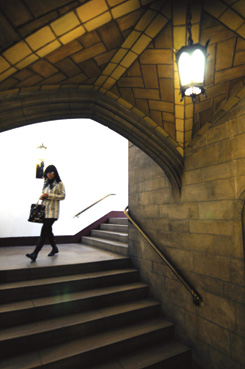Editor's Note
Sacred Spaces
Setting is everything. In the short history of this magazine and our running feature “Go Ask Alumni,” we’ve never received nearly as many alumni responses as we did to the question for this issue: what location on campus or in Hyde Park stands out in your memory? We heard from dozens of you, not only College alumni but graduate alumni, as well. Variety reigned, with only a few locations receiving repeat valentines: Jimmy’s, Regenstein Library, and University Theater. Selected answers appear on pages 27–30, complete with Dan Dry photographs of how these favorite places looked one sunny Monday this October.
Some responses provided a glimpse of the past, since many sites on campus have been significantly renovated, updated, refurbished—or have become new places altogether. Veronica C. Wald, AB’71, remembered moving into Woodward Court in 1968, where “I spent my first year sleeping and studying in my little cinderblock cell and whooping it up at dinnertime in the Common Unit cafeteria.” Today she works for the GSB in an office at Harper Center, where that cafeteria once stood.
Other places seem eternal. John Dietmann, AB’63, AM’65, remembered “Bond Chapel, where in the afternoons I could sit quietly and think about things I couldn’t understand at first” (see the inside front cover for a peek). Dietmann also made mention of Jimmy’s Woodlawn Tap, where he met his wife Diane Scherr Dietmann, AM’71, “whilst tending bar there as a graduate student.”
Love figured into the answer, too, of Maurice Fulton, AB’40, JD’42. Mr. Fulton named an unmoored, impermanent place where, nonetheless, an enduring relationship took shape—and he reminded us along the way of a time when many students commuted to the College: “I spent my entire U of C student life as a commuter,” he wrote. “One and a half hours each way with a transfer at 61st and Kedzie. But the fare was seven cents. That was the direct way! Sometimes I would escort my beloved Muriel Fantus to the IC, ride downtown with her, and then work my way home. So, you see, I probably spent as much time on a streetcar as in a classroom. The location issue was really where on the streetcar—in or out, seat or outside windswept platform? But it all worked!!” Particularly for him and Mrs. Muriel Fantus Fulton, X’43.
Bill Wilkin, SM’70, also invoked a place that moved him in more ways than one: an elevator dubbed the “Ryerson Rocket” for its “stately progress from floor to floor” of the building in question. “I rarely took it, preferring the stairs,” he wrote. “However, I did take that elevator when I wanted time of solitude for reflection or when I wanted to delay getting to an appointment that I was dreading.” Other places were significant less for themselves than for their inhabitants; David Chernoff, AB’60, JD’62, wrote: “Discussions with with Jock Weintraub in his office. Nothing more need be said.” (Incidentally, see pages 6–7 for an interview with the first holder of the faculty chair named for Professor Weintraub).
I’ve experienced my share of significant life moments around this campus. The place my mind fled to when I posed myself this question, however, wasn’t any of those, but an everyday place where previous generations have left their subtle imprint: the vaulted stone staircase in Harper Tower West, generously wide and gently winding, each stair worn to a smooth concavity where thousands of students have treaded over the years.—L.D.
